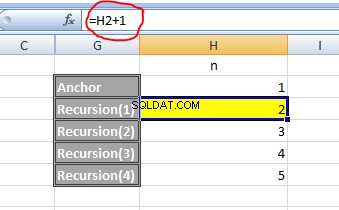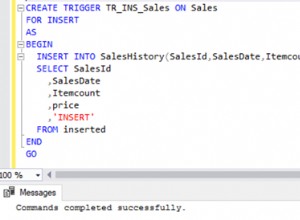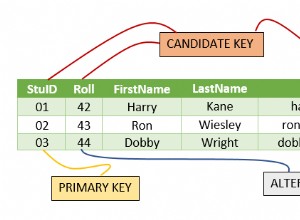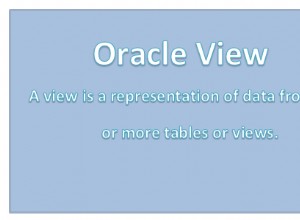No he probado su código, solo traté de ayudarlo a comprender cómo funciona en el comentario;
WITH
cteReports (EmpID, FirstName, LastName, MgrID, EmpLevel)
AS
(
-->>>>>>>>>>Block 1>>>>>>>>>>>>>>>>>
-- In a rCTE, this block is called an [Anchor]
-- The query finds all root nodes as described by WHERE ManagerID IS NULL
SELECT EmployeeID, FirstName, LastName, ManagerID, 1
FROM Employees
WHERE ManagerID IS NULL
-->>>>>>>>>>Block 1>>>>>>>>>>>>>>>>>
UNION ALL
-->>>>>>>>>>Block 2>>>>>>>>>>>>>>>>>
-- This is the recursive expression of the rCTE
-- On the first "execution" it will query data in [Employees],
-- relative to the [Anchor] above.
-- This will produce a resultset, we will call it R{1} and it is JOINed to [Employees]
-- as defined by the hierarchy
-- Subsequent "executions" of this block will reference R{n-1}
SELECT e.EmployeeID, e.FirstName, e.LastName, e.ManagerID,
r.EmpLevel + 1
FROM Employees e
INNER JOIN cteReports r
ON e.ManagerID = r.EmpID
-->>>>>>>>>>Block 2>>>>>>>>>>>>>>>>>
)
SELECT
FirstName + ' ' + LastName AS FullName,
EmpLevel,
(SELECT FirstName + ' ' + LastName FROM Employees
WHERE EmployeeID = cteReports.MgrID) AS Manager
FROM cteReports
ORDER BY EmpLevel, MgrID
El ejemplo más simple de un CTE recursivo que se me ocurre para ilustrar su funcionamiento es;
;WITH Numbers AS
(
SELECT n = 1
UNION ALL
SELECT n + 1
FROM Numbers
WHERE n+1 <= 10
)
SELECT n
FROM Numbers
P 1) cómo se incrementa el valor de N. si el valor se asigna a N cada vez, el valor N se puede incrementar, pero solo se inicializó el valor N la primera vez .
A1: En este caso, N no es una variable N es un alias. Es el equivalente a SELECT 1 AS N . Es una sintaxis de preferencia personal. Hay 2 métodos principales de alias de columnas en un CTE en T-SQL . He incluido el análogo de un simple CTE en Excel para tratar de ilustrar de una manera más familiar lo que está sucediendo.
-- Outside
;WITH CTE (MyColName) AS
(
SELECT 1
)
-- Inside
;WITH CTE AS
(
SELECT 1 AS MyColName
-- Or
SELECT MyColName = 1
-- Etc...
)

P 2) ahora aquí sobre CTE y la recurrencia de la relación de los empleados en el momento en que agrego dos gerentes y agrego algunos empleados más bajo el segundo gerente, luego comienza el problema. Quiero mostrar los detalles del primer gerente y en las siguientes filas solo aparecerán los detalles de esos empleados aquellos que son subordinados de ese gerente
A2:
¿Responde este código a tu pregunta?
--------------------------------------------
-- Synthesise table with non-recursive CTE
--------------------------------------------
;WITH Employee (ID, Name, MgrID) AS
(
SELECT 1, 'Keith', NULL UNION ALL
SELECT 2, 'Josh', 1 UNION ALL
SELECT 3, 'Robin', 1 UNION ALL
SELECT 4, 'Raja', 2 UNION ALL
SELECT 5, 'Tridip', NULL UNION ALL
SELECT 6, 'Arijit', 5 UNION ALL
SELECT 7, 'Amit', 5 UNION ALL
SELECT 8, 'Dev', 6
)
--------------------------------------------
-- Recursive CTE - Chained to the above CTE
--------------------------------------------
,Hierarchy AS
(
-- Anchor
SELECT ID
,Name
,MgrID
,nLevel = 1
,Family = ROW_NUMBER() OVER (ORDER BY Name)
FROM Employee
WHERE MgrID IS NULL
UNION ALL
-- Recursive query
SELECT E.ID
,E.Name
,E.MgrID
,H.nLevel+1
,Family
FROM Employee E
JOIN Hierarchy H ON E.MgrID = H.ID
)
SELECT *
FROM Hierarchy
ORDER BY Family, nLevel
Otro sql con estructura de árbol
SELECT ID,space(nLevel+
(CASE WHEN nLevel > 1 THEN nLevel ELSE 0 END)
)+Name
FROM Hierarchy
ORDER BY Family, nLevel




